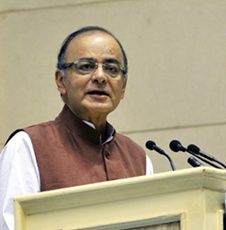Economic Survey projects FY16 GDP growth rate at 8.1-8.5%
27 Feb 2015
 The Economic Survey 2014-15, tabled in Parliament by finance minister Arun Jaitley today, projects an acceleration in economic growth rate to levels of 8.1-8.5 per cent in fiscal 2015-16, boosted by the cumulative impact of reforms and benign inflation.
The Economic Survey 2014-15, tabled in Parliament by finance minister Arun Jaitley today, projects an acceleration in economic growth rate to levels of 8.1-8.5 per cent in fiscal 2015-16, boosted by the cumulative impact of reforms and benign inflation.
The Survey also bases its projection on a likely monetary policy easing facilitated by lower inflation and improved inflationary expectations and, of course, a normal monsoon.
Using the new estimate (with 2011-12 as the base), GDP growth at constant market prices for 2015-16 is expected to accelerate to between 8.1 and 8.5 per cent and further to double digits above 10 per cent in the following fiscal.
India's economy grew at a faster pace of 6.9 per cent in 2013-14 as well, according to a new series of gross domestic product (GDP), against the 4.7 per cent estimated earlier under the earlier series.
It also indicated that the growth during 2014-15 could touch eight per cent on the back of better farm output. The Central Statistical Office had projected growth at 7.4 per cent for current fiscal.
The Survey noted that several reforms have been undertaken and more are on the anvil. The introduction of the goods and services tax and expanding direct benefit transfers can be game-changers, it said.
The major reforms undertaken by the government include deregulation of diesel prices, direct transfer of cooking gas subsidy, increasing the limit on foreign direct investment in defence and insurance, and the ordinance on coal mine allocation.
Low margins bite
Over the medium term, the Survey said growth prospects will be conditioned by the ''balance sheet syndrome with Indian characteristics'' that has the potential to hold back rapid increases in private sector investment.
The Survey estimates the stock of stalled projects at about 7 per cent of GDP, accounted for mostly by the private sector. Manufacturing and infrastructure account for most of the stalled projects.
This has weakened the balance sheets of the corporate sector and public sector banks, which in turn is constraining future private investment, completing a vicious circle.
Despite high rates of stalling, and weak balance sheets, the stock market valuations of companies with stalled projects are quite robust, which shows the disconnect between real economy and the stock market.
Combining the situation of Indian public sector banks and corporate balance sheets suggests that the expectation that the private sector will drive investment needs to be moderated. In this light, public investment may need to step in to ramp up capital formation and recreate an environment to crowd-in the private sector.
Private investment must be the engine of long-run growth. However, there is a case for reviving targeted public investment as an engine of growth in the short run to complement and crowd-in private investment, it said.
''India can balance the short-term imperative of boosting public investment to revitalise growth with the need to maintain fiscal discipline. Expenditure control, and expenditure switching from consumption to investment, will be key,'' it added.
External economy
Even as the Survey stated that macro economic situation in the country has improved significantly in the current year, it raised concerns over growth pattern in exports, construction and mining activities.
The outlook of low oil prices and falling imports is favourable for the current account deficit and its financing, the Survey noted, even as it warned against unchecked forex inflows.
''A likely surfeit, rather than scarcity, of foreign capital will complicate exchange rate management. Reconciling the benefits of these flows with their impact on exports and the current account remains an important challenge going forward.
''India faces an export challenge, reflected in the fact that the share of manufacturing and services exports in GDP has stagnated in the last five years. The external trading environment is less benign in two ways: partner country growth and their absorption of Indian exports have slowed, and mega-regional trade agreements being negotiated by the major trading nations in Asia and Europe threaten to exclude India and place its exports at a competitive disadvantage,'' the Survey pointed out.
''Structural shifts in the inflationary process are underway due to lower oil prices, deceleration in agriculture prices and wages, and dramatically improved household inflation expectations. Going forward inflation is likely to remain in the 5-5.5 per cent range, creating space for easing of monetary conditions,'' the Survey stated.
However, the Survey said, India must adhere to the medium-term fiscal deficit target of 3 per cent of GDP. This will provide the fiscal space to insure against future shocks and also to move closer to the fiscal performance of its emerging market peers.
India must also reverse the trajectory of recent years and move toward the golden rule of eliminating revenue deficits and ensuring that, over the cycle, borrowing is only for capital formation.













.jpg)






.jpg)









